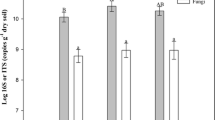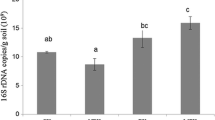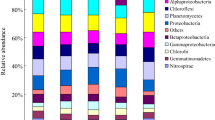Abstract
Understanding the responses of soil microbiome composition to various farming practices is important for selecting suitable managements to maintain soil functions. In this study, the influences of heavy chemical fertilizer application (CF) and reduced chemical fertilizer supplemented with organic (OF) or bioorganic fertilizer (BF, BF = OF + Trichoderma) on composition of soil microbiome were investigated for monocropping cucumber systems using a five-season continuous pot experiment. The MiSeq sequencing data indicated that the CF treatment resulted in the lowest fungal diversity and the BF treatment resulted in a relatively higher one close to the initial soil (CK). The BF and OF treatments had similar impacts on the composition of bacterial community, and the CF treatment significantly reduced bacterial diversity. Although both OF and BF treatments had better plant growth responses, they had less disturbance on the composition of fungal community relative to the CF treatment. The BF treatment is more predictable than the other treatments for postponing fungal diversity as the inoculated fungal species significantly (p < 0.05) affected the fungal community. In conclusion, the combination of bioorganic fertilizers with reduced chemical fertilizer application can maintain a diverse soil microbiome in cucumber monocropping.




Similar content being viewed by others
References
Adesemoye AO, Kloepper JW (2009) Plant–microbes interactions in enhanced fertilizer-use efficiency. Appl Microbiol Biotechnol 85:1–12. doi:10.1007/s00253-009-2196-0
Adesemoye AO, Torbert HA, Kloepper JW (2010) Increased plant uptake of nitrogen from 15N-depleted fertilizer using plant growth-promoting rhizobacteria. Appl Soil Ecol 46:54–58. doi:10.1016/j.apsoil.2010.06.010
Ai C, Liang G, Sun J, Wang X, He P, Zhou W, He X (2015) Reduced dependence of rhizosphere microbiome on plant-derived carbon in 32-year long-term inorganic and organic fertilized soils. Soil Biol Biochem 80:70–78. doi:10.1016/j.soilbio.2014.09.028
Altomare C, Tringovska I (2011) Beneficial soil microorganisms, an ecological alternative for soil fertility management. In: Lichtfouse E (ed) Genetics, biofuels and local farming systems. Springer, Dordrecht, pp 161–214
Bakker MG, Chaparro JM, Manter DK, Vivanco JM (2015) Impacts of bulk soil microbial community structure on rhizosphere microbiomes of Zea mays. Plant Soil 392:115–126. doi:10.1007/s11104-015-2446-0
Barns SM, Takala SL, Kuske CR (1999) Wide distribution and diversity of members of the bacterial kingdom Acidobacterium in the environment. Appl Environ Microbiol 65:1731–1737
Berendsen RL, Pieterse CMJ, Bakker PAHM (2012) The rhizosphere microbiome and plant health. Trends Plant Sci 17:478–486. doi:10.1016/j.tplants.2012.04.001
Besemer K, Peter H, Logue JB, Langenheder S, Lindström ES, Tranvik LJ, Battin TJ (2012) Unraveling assembly of stream biofilm communities. ISME J 6:1459–1468
Cai F, Chen W, Wei Z, Guan P, Li R, Ran W, Shen Q (2015) Colonization of Trichoderma harzianum strain SQR-T037 on tomato roots and its relationship to plant growth, nutrient availability and soil microflora. Plant Soil 388:337–350. doi:10.1007/s11104-014-2326-z
Chávez R, Bull P, Eyzaguirre J (2006) The xylanolytic enzyme system from the genus Penicillium. J Biotechnol 123:413–433. doi:10.1016/j.jbiotec.2005.12.036
Chen L, Yang X, Raza W, Li J, Liu Y, Qiu M, Zhang F, Shen Q (2011) Trichoderma harzianum SQR-T037 rapidly degrades allelochemicals in rhizospheres of continuously cropped cucumbers. Appl Microbiol Biotechnol 89:1653–1663. doi:10.1007/s00253-010-2948-x
Chu H, Lin X, Fujii T, Morimoto S, Yagi K, Hu J, Zhang J (2007) Soil microbial biomass, dehydrogenase activity, bacterial community structure in response to long-term fertilizer management. Soil Biol Biochem 39:2971–2976. doi:10.1016/j.soilbio.2007.05.031
Crecchio C, Curci M, Pellegrino A, Ricciuti P, Tursi N, Ruggiero P (2007) Soil microbial dynamics and genetic diversity in soil under monoculture wheat grown in different long-term management systems. Soil Biol Biochem 39:1391–1400. doi:10.1016/j.soilbio.2006.12.016
Cytryn E, Kautsky L, Ofek M, Mandelbaum RT, Minz D (2011) Short-term structure and functional changes in bacterial community composition following amendment with biosolids compost. Appl Soil Ecol 48:160–167. doi:10.1016/j.apsoil.2011.03.010
de Castro VH, Schroeder LF, Quirino BF, Kruger RH, Barreto CC (2013) Acidobacteria from oligotrophic soil from the Cerrado can grow in a wide range of carbon source concentrations. Can J Microbiol 59:746–753. doi:10.1139/cjm-2013-0331
Esperschütz J, Gattinger A, Mäder P, Schloter M, Fließbach A (2007) Response of soil microbial biomass and community structures to conventional and organic farming systems under identical crop rotations: response of soil microbial biomass and community structures. FEMS Microbiol Ecol 61:26–37. doi:10.1111/j.1574-6941.2007.00318.x
Fierer N, Jackson RB (2006) The diversity and biogeography of soil bacterial communities. Proc Nati Aca Sci U S A 103:626–631. doi:10.1073/pnas.0507535103
Gómez JP, Bravo GA, Brumfield RT, Tello JG, Cadena CD (2010) A phylogenetic approach to disentangling the role of competition and habitat filtering in community assembly of neotropical forest birds: antbird phylogenetic community ecology. J Anim Ecol 79:1181–1192. doi:10.1111/j.1365-2656.2010.01725.x
Harman GE, Howell CR, Viterbo A, Chet I, Lorito M (2004) Trichoderma species—opportunistic, avirulent plant symbionts. Nat Rev Microbiol 2:43–56. doi:10.1038/nrmicro797
Hervás A, Landa B, Datnoff LE, Jiménez-Díaz RM (1998) Effects of commercial and indigenous microorganisms on Fusarium wilt development in chickpea. Biol Control 13:166–176
Högberg MN, Yarwood SA, Myrold DD (2014) Fungal but not bacterial soil communities recover after termination of decadal nitrogen additions to boreal forest. Soil Biol Biochem 72:35–43. doi:10.1016/j.soilbio.2014.01.014
Huang X, Chen L, Ran W, Shen Q, Yang X (2011) Trichoderma harzianum strain SQR-T37 and its bio-organic fertilizer could control Rhizoctonia solani damping-off disease in cucumber seedlings mainly by the mycoparasitism. Appl Microbiol Biotechnol 91:741–755. doi:10.1007/s00253-011-3259-6
Huang L-F, Song L-X, Xia X-J, Mao W-H, Shi K, Zhou Y-H, Yu J-Q (2013) Plant-soil feedbacks and soil sickness: from mechanisms to application in agriculture. J Chem Ecol 39:232–242. doi:10.1007/s10886-013-0244-9
Huang X, Liu L, Wen T, Zhu R, Zhang J, Cai Z (2015) Illumina MiSeq investigations on the changes of microbial community in the Fusarium oxysporum f.sp. cubense infected soil during and after reductive soil disinfestation. Microbiol Res 181:33–42. doi:10.1016/j.micres.2015.08.004
Jumpponen A, Jones KL (2010) Seasonally dynamic fungal communities in the Quercus macrocarpa phyllosphere differ between urban and nonurban environments. New Phytol 186:496–513. doi:10.1111/j.1469-8137.2010.03197.x
Kozich JJ, Westcott SL, Baxter NT, Highlander SK, Schloss PD (2013) Development of a dual-index sequencing strategy and curation pipeline for analyzing amplicon sequence data on the MiSeq Illumina sequencing platform. Appl Environ Microbiol 79:5112–5120. doi:10.1128/AEM.01043-13
Leaw SN, Chang HC, Sun HF, Barton R, Bouchara JP, Chang TC (2006) Identification of medically important yeast species by sequence analysis of the internal transcribed spacer regions. J Clin Microbiol 44:693–699. doi:10.1128/JCM.44.3.693-699.2006
Li C, Li X, Kong W, Wu Y, Wang J (2010) Effect of monoculture soybean on soil microbial community in the Northeast China. Plant Soil 330:423–433. doi:10.1007/s11104-009-0216-6
Li X, Ding C, Zhang T, Wang X (2014) Fungal pathogen accumulation at the expense of plant-beneficial fungi as a consequence of consecutive peanut monoculturing. Soil Biol Biochem 72:11–18. doi:10.1016/j.soilbio.2014.01.019
Li X, Sun M, Zhang H, Xu N, Sun G (2016) Use of mulberry–soybean intercropping in salt–alkali soil impacts the diversity of the soil bacterial community. Microb Biotechnol 9:293–304. doi:10.1111/1751-7915.12342
Liu X, Herbert SJ (2002) Fifteen years of research examining cultivation of continuous soybean in northeast China: a review. Field Crops Res 79:1–7
Nacke H, Thürmer A, Wollherr A, Will C, Hodac L, Herold N, Schöning I, Schrumpf M, Daniel R (2011) Pyrosequencing-based assessment of bacterial community structure along different management types in German forest and grassland soils. PLoS One 6:e17000. doi:10.1371/journal.pone.0017000
Naether A, Foesel BU, Naegele V, Wüst PK, Weinert J, Bonkowski M, Alt F, Oelmann Y, Polle A, Lohaus G, Gockel S, Hemp A, Kalko EK, Linsenmair KE, Pfeiffer S, Renner S, Schöning I, Weisser WW, Wells K, Fischer M, Overmann J, Friedrich MW (2012) Environmental factors affect acidobacterial communities below the subgroup level in grassland and forest soils. Appl Environ Microbiol 78:7398–7406. doi:10.1128/AEM.01325-12
Nayyar A, Hamel C, Lafond G, Gossen B, Hanson K, Germida J (2009) Soil microbial quality associated with yield reduction in continuous-pea. Appl Soil Ecol 43:115–121. doi:10.1016/j.apsoil.2009.06.008
Orr CH, Leifert C, Cummings SP, Cooper JM (2012) Impacts of organic and conventional crop management on diversity and activity of free-living nitrogen fixing bacteria and total bacteria are subsidiary to temporal effects. PLoS One 7:e52891. doi:10.1371/journal.pone.0052891
Pii Y, Mimmo T, Tomasi N, Terzano R, Cesco S, Crecchio C (2015) Microbial interactions in the rhizosphere: beneficial influences of plant growth-promoting rhizobacteria on nutrient acquisition process. A review. Biol Fertil Soils 51:403–415. doi:10.1007/s00374-015-0996-1
Qiu M, Li S, Zhou X, Cui X, Vivanco JM, Zhang N, Shen Q, Zhang R (2014) De-coupling of root–microbiome associations followed by antagonist inoculation improves rhizosphere soil suppressiveness. Biol Fertil Soils 50:217–224. doi:10.1007/s00374-013-0835-1
Reino JL, Guerrero RF, Hernández-Galán R, Collado IG (2007) Secondary metabolites from species of the biocontrol agent Trichoderma. Phytochem Rev 7:89–123. doi:10.1007/s11101-006-9032-2
Romaniuk R, Giuffré L, Costantini A, Nannipieri P (2011) Assessment of soil microbial diversity measurements as indicators of soil functioning in organic and conventional horticulture systems. Ecol Indic 11:1345–1353. doi:10.1016/j.ecolind.2011.02.008
Rousk J, Bååth E, Brookes PC, Lauber CL, Lozupone C, Caporaso JG, Knight R, Fierer N (2010) Soil bacterial and fungal communities across a pH gradient in an arable soil. ISME J 4:1340–1351. doi:10.1038/ismej.2010.58
Saha S, Prakash V, Kundu S, Kumar N, Mina BL (2008) Soil enzymatic activity as affected by long term application of farm yard manure and mineral fertilizer under a rainfed soybean–wheat system in N-W Himalaya. Eur J Soil Biol 44:309–315. doi:10.1016/j.ejsobi.2008.02.004
Sanguin H, Sarniguet A, Gazengel K, Moënne-Loccoz Y, Grundmann GL (2009) Rhizosphere bacterial communities associated with disease suppressiveness stages of take-all decline in wheat monoculture. New Phytol 184:694–707. doi:10.1111/j.1469-8137.2009.03010.x
Shen Z, Wang D, Ruan Y, Xue C, Zhang J, Li R, Shen Q (2014) Deep 16S rRNA pyrosequencing reveals a bacterial community associated with banana Fusarium wilt disease suppression induced by bio-organic fertilizer application. PLoS One 9:e98420. doi:10.1371/journal.pone.0098420
Shen Z, Ruan Y, Chao X, Zhang J, Li R, Shen Q (2015) Rhizosphere microbial community manipulated by 2 years of consecutive biofertilizer application associated with banana Fusarium wilt disease suppression. Biol Fertil Soils 51:553–562. doi:10.1007/s00374-015-1002-7
Sinninghe Damsté JS, Rijpstra WIC, Geenevasen JAJ, Strous M, Jetten MSM (2005) Structural identification of ladderane and other membrane lipids of planctomycetes capable of anaerobic ammonium oxidation (anammox): membrane lipids of anammox bacteria. FEBS J 272:4270–4283. doi:10.1111/j.1742-4658.2005.04842.x
Somai BM, Dean RA, Farnham MW, Zitter TA, Keinath AP (2002) Internal transcribed spacer regions 1 and 2 and random amplified polymorphic DNA analysis of Didymella bryoniae and related Phoma species isolated from cucurbits. Phytopathology 92:997–1004
ter Braak CJF, Smilauer P (2002) CANOCO reference manual and CanoDraw for Windows user’s guide: software for canonical community ordination (version 4.5). Biometrics, Ithaca NY
Tian W, Wang L, Li Y, Zhuang K, Li G, Zhang J, Xiao X, Xi Y (2015) Responses of microbial activity, abundance, and community in wheat soil after three years of heavy fertilization with manure-based compost and inorganic nitrogen. Agric Ecosyst Environ 213:219–227. doi:10.1016/j.agee.2015.08.009
Wang B, Li R, Ruan Y, Ou Y, Zhao Y, Shen Q (2015) Pineapple–banana rotation reduced the amount of Fusarium oxysporum more than maize–banana rotation mainly through modulating fungal communities. Soil Biol Biochem 86:77–86. doi:10.1016/j.soilbio.2015.02.021
Ward NL, Challacombe JF, Janssen PH, Henrissat B, Coutinho PM, Wu M, Xie G, Haft DH, Sait M, Badger J, Barabote RD, Bradley B, Brettin TS, Brinkac LM, Bruce D, Creasy T, Daugherty SC, Davidsen TM, DeBoy RT, Detter JC, Dodson RJ, Durkin AS, Ganapathy A, Gwinn-Giglio M, Han CS, Khouri H, Kiss H, Kothari SP, Madupu R, Nelson KE, Nelson WC, Paulsen I, Penn K, Ren Q, Rosovitz MJ, Selengut JD, Shrivastava S, Sullivan SA, Tapia R, Thompson LS, Watkins KL, Yang Q, Yu C, Zafar N, Zhou L, Kuske CR (2009) Three genomes from the phylum acidobacteria provide insight into the lifestyles of these microorganisms in soils. Appl Environ Microbiol 75:2046–2056. doi:10.1128/AEM.02294-08
Werner D, Newton WE (eds) (2005) Nitrogen fixation in agriculture, forestry, ecology, and the environment. Springer, Dordrecht
Wu K, Yuan S, Wang L, Shi J, Zhao J, Shen B, Shen Q (2014) Effects of bio-organic fertilizer plus soil amendment on the control of tobacco bacterial wilt and composition of soil bacterial communities. Biol Fertil Soils 50:961–971. doi:10.1007/s00374-014-0916-9
Xu L, Ravnskov S, Larsen J, Nilsson RH, Nicolaisen M (2012) Soil fungal community structure along a soil health gradient in pea fields examined using deep amplicon sequencing. Soil Biol Biochem 46:26–32. doi:10.1016/j.soilbio.2011.11.010
Xun W, Huang T, Zhao J, Ran W, Wang B, Shen Q (2015) Environmental conditions rather than microbial inoculum composition determine the bacterial composition, microbial biomass and enzymatic activity of reconstructed soil microbial communities. Soil Biol Biochem 90:10–18. doi:10.1016/j.soilbio.2015.07.018
Yousuf B, Keshri J, Mishra A, Jha B (2012) Application of targeted metagenomics to explore abundance and diversity of CO2-fixing bacterial community using cbbL gene from the rhizosphere of Arachis hypogaea. Gene 506:18–24. doi:10.1016/j.gene.2012.06.083
Yuan J, Chaparro JM, Manter DK, Zhang R, Vivanco JM, Shen Q (2015) Roots from distinct plant developmental stages are capable of rapidly selecting their own microbiome without the influence of environmental and soil edaphic factors. Soil Biol Biochem 89:206–209. doi:10.1016/j.soilbio.2015.07.009
Zhang F, Zhu Z, Yang X, Ran W, Shen Q (2013) Trichoderma harzianum T-E5 significantly affects cucumber root exudates and fungal community in the cucumber rhizosphere. Appl Soil Ecol 72:41–48. doi:10.1016/j.apsoil.2013.05.016
Zhao J, Ni T, Li Y, Xiong W, Ran W, Shen B, Shen Q, Zhang R (2014a) Responses of bacterial communities in arable soils in a rice-wheat cropping system to different fertilizer regimes and sampling times. PLoS One 9:e85301. doi:10.1371/journal.pone.0085301
Zhao J, Zhang R, Xue C, Xun W, Sun L, Xu Y, Shen Q (2014b) Pyrosequencing reveals contrasting soil bacterial diversity and community structure of two main winter wheat cropping systems in China. Microb Ecol 67:443–453. doi:10.1007/s00248-013-0322-0
Acknowledgments
This research was supported by the National Key Technology R&D Program of the Ministry of Science and Technology of China (2013BAD20B05 and L0201400202).
Author information
Authors and Affiliations
Corresponding author
Electronic supplementary material
Table S1
(DOCX 17 kb).
Fig. S1
Hierarchical cluster tree of bacterial (a) and fungal (b) communities. Pairwise Bray-Curtis dissimilarity of samples collected from different soil samples: CK, initial soil sample collected before planting and fertilization; CF, 100% chemical fertilizer; BF, 75% chemical fertilizer + bioorganic fertilizer; OF, 75% chemical fertilizer + organic fertilizer. (GIF 10 kb).
Fig. S2
Rarefaction curves of bacterial (a) and fungal (b) communities based on observed OTUs at 3% distance for individual sample. CK, initial soil sample collected before planting and fertilization; CF, 100% chemical fertilizer; BF, 75% chemical fertilizer + bioorganic fertilizer; OF, 75% chemical fertilizer + organic fertilizer. (GIF 107 kb).
Fig. S3
Venn diagram of bacterial (a) and fungal (b) communities. CK, initial soil sample collected before planting and fertilization; CF, 100% chemical fertilizer; BF, 75% chemical fertilizer + bioorganic fertilizer; OF, 75% chemical fertilizer + organic fertilizer. (GIF 290 kb).
Rights and permissions
About this article
Cite this article
Cai, F., Pang, G., Li, RX. et al. Bioorganic fertilizer maintains a more stable soil microbiome than chemical fertilizer for monocropping. Biol Fertil Soils 53, 861–872 (2017). https://doi.org/10.1007/s00374-017-1216-y
Received:
Revised:
Accepted:
Published:
Issue Date:
DOI: https://doi.org/10.1007/s00374-017-1216-y




